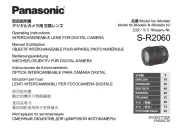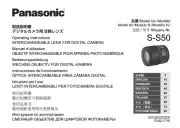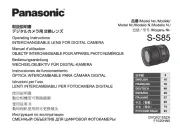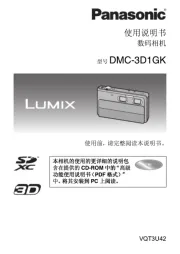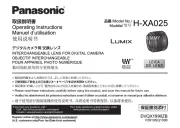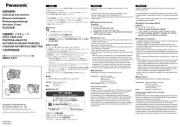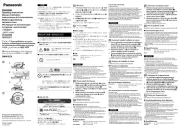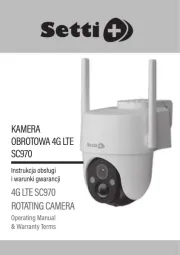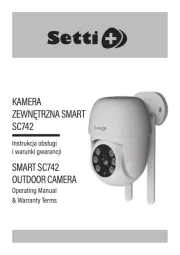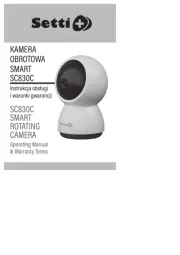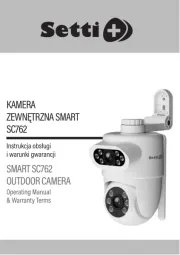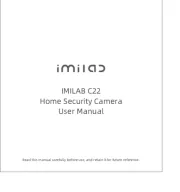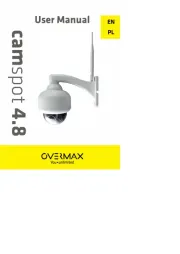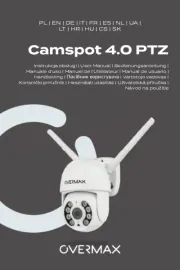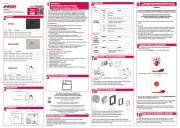Thank you for purchasing Panasonic product.
Please read these instructions carefully before using this product, and
save this manual for future use.
This lens can be attached for use to a digital camera that complies with
the Leica Camera AG L-Mount standard.
It is compatible with a 35 mm full-frame image sensor.
•For smoother recording, we recommend updating the firmware of the
digital camera/lens to the latest version.
•For the latest information on the firmware or to download/update the
firmware, visit the following support website:
https://panasonic.jp/support/global/cs/dsc/
(English only)
•
L-Mount is a trademark or registered trademark of Leica Camera AG.
•
Other names, company names, product names mentioned in this document
are trademarks or registered trademarks of the companies concerned.
•The appearance and specifications of products described in this
document may differ from the actual products you have purchased
due to later enhancements.
Keep the unit as far away as possible from electromagnetic
equipment (such as microwave ovens, TVs, video games, radio
transmitters, high-voltage lines etc.).
•Do not use the camera near cell phones because doing so may result
in noise adversely affecting the pictures and sound.
•If the camera is adversely affected by electromagnetic equipment and
stops functioning properly, turn the camera off and remove the battery
and/or the connected AC adaptor. Then reinsert the battery and/or
reconnect the AC adaptor and turn the camera on.
-If you see this symbol-
∫Handling of the lens
•When using this lens, take care not to drop, bump, or apply
undue force to it. Doing so may cause malfunction or damage to
this lens and the digital camera.
•Images may be affected by dust, dirt, and soiling (water, oil,
fingerprints, etc.) on the lens surface. Before and after recording, use
a blower to blow off dust and dirt from the surface of the lens, then
lightly wipe with a soft dry cloth to remove soiling.
•
When the lens is not in use, be sure to attach the lens cap and lens rear cap
to prevent dust and other particles from accumulating on or entering the lens.
•To protect the lens contact points 1, do not do the following. These
may cause malfunction.
(See illustration )
–Touch the lens contact points.
–Allow the lens contact points to become dirty.
–Place the lens with its mount surface facing down.
∫Dust and splash resistant
•Splash Resistant and Dust Resistant are terms used to describe
an extra level of protection this lens offers against exposure to a
minimal amount of moisture, water or dust. These terms do not
guarantee that damage will not occur if this lens is subjected to
direct contact with water or dust infiltration.
Take the following precautions to provide satisfactory dust and
splash resistant performance. If the lens is not working properly,
consult the dealer or Panasonic.
–Attach to a digital camera that is dust and splash resistant.
–
When attaching or removing the lens, be careful so that foreign
objects such as sand, dust, and water droplets do not adhere to or
enter the lens mount rubber, contact points, digital camera and lens.
–If the lens is exposed to water droplets or other liquids, wipe them
off with a soft, dry cloth.
•To improve the dust and splash resistant performance of the lens, a
lens mount rubber is used in the mount.
–The lens mount rubber will leave scuff marks on the digital camera
mount, but this does not impact performance.
–
For information on changing the lens mount rubber, contact Panasonic.
∫Condensation (when the lens is fogged up)
•
Condensation occurs when the ambient temperature or humidity changes.
Please be careful, as it may cause lens stains, mold and malfunction.
•
If condensation occurs, turn off the digital camera and leave it for approx. 2
hours. The fog will disappear naturally when the temperature of the digital
camera becomes close to the ambient temperature.
Check that all the accessories are supplied before using the product.
Product numbers correct as of September 2022. These may be subject
to change.
1Lens hood
2Lens cap¢
3Lens rear cap¢
¢Fitted to the lens at the time of purchase.
1Lens surface
2Focus ring
Rotates the focus ring to focus when set to MF (Manual Focus).
You can set the amount of movement for focusing using the focus
ring with the menus in compatible digital cameras. Refer to the
operating instructions for the digital camera for details.
3AF/MF switch
Switches between AF (Auto Focus) and MF (Manual Focus).
•
When the digital camera is set to MF, the operation will be MF
irrespective of the setting on the AF/MF switch.
4Contact points
5Lens mount rubber
6Lens fitting mark
Note
•
While shooting video, in some situations, AF operation of the lens may be
heard. In such situations changing to MF will improve this situation.
•
There may be some vignetting at the edges of the screen when recording
at a wide angle using the flash. We recommend using the wide panel on
an external flash to solve the vignetting issue.
•
When flash recording with a close subject, the light of the flash will be
blocked by the lens and part of the picture may be dark. Check the
distance from the subject when recording.
For information on how to attach the lens, refer to the operating
instructions for your digital camera.
•Attach the lens after turning off the digital camera.
•
Attach the lens after removing the lens rear cap. (See illustration )
•After removing the lens from the digital camera, be sure to attach the
lens cap and lens rear cap to prevent dust and other particles from
accumulating on or entering the lens.
∫Attaching the lens hood (See illustration / )
Hold the lens hood with your fingers placed as shown in the picture.
•Do not hold the lens hood in a way that twists or bends it.
1Align mark A
A
A
AA ( ) on the lens hood with the mark on the
tip of the lens.
2
Rotate the lens hood in the direction of the arrow to align mark
B
B
B
BB
( ) on the lens hood with the mark on the tip of the lens.
• Attach the lens hood by rotating it until it clicks.
∫Removing the lens hood (See illustration )
While pressing the lens hood button
C
, rotate the lens hood in the
direction of the arrow and then remove it.
Note
•When carrying, the lens hood can be attached in the reverse
direction. (See illustration )
1
Align mark
B
( ) on the lens hood with the mark on the tip of the lens.
2
Attach the lens hood by rotating it in the direction of the arrow until it clicks.
•It is recommended to remove the lens hood during flash photography
as the lens hood can block the light from the flash.
•To prevent dropping of the lens, you should never carry the lens by
just holding the lens hood.
∫Notes on filter use
•It is possible to attach the lens cap or the lens hood with the filter
already attached.
•There may be some vignetting in recorded images if multiple filters
are attached simultaneously.
•
It is not possible to attach any items other than filters such as a conversion
lens or adaptor to the front of t it in combinathe lens and use ion with this lens.
Lens damage may result if such items are attached.
•Do not spray the lens with insecticides or volatile chemicals.
–If such substances get onto the lens they can damage the exterior
case or cause the paint to peel.
•Do not point the lens at the sun or other strong light sources.
–This may cause the lens to collect an excessive amount of light,
resulting in fire and malfunction.
•Do not use while directly touching the lens at low temperatures
for a long period of time.
–In cold places (environments below 0 o oC (32 F), such as ski
slopes), prolonged direct contact with the lens may cause skin
injury. Use gloves or similar when using the lens for long periods.
•When cleaning, wipe lightly using a soft dry cloth that does not
produce dust.
–Do not use solvents such as benzine, thinners, alcohol, kitchen
cleansers, etc., as this can cause problems such as deformation of
the casing or peeling of the coating.
–Do not use wipes with chemicals.
•Do not keep products made of rubber, PVC or similar materials in
contact with the lens for a long period of time.
•Do not disassemble or alter this product.
•When the lens is not going to be used for a prolonged period, we
recommend storing with a desiccant (silica gel).
•Check all the parts before recording when you have not used the lens
for a long period of time.
•Avoid using or storing the lens in any of the following locations as this
may cause problems in operation or malfunctioning:
–In direct sunlight or on a beach in summer
–In locations with high temperatures and humidity levels or severe
changes in temperature and humidity
–In sandy or dusty locations
–Where there is fire
–Near heaters, air conditioners or humidifiers
–Where water may make the lens wet
–Where there is vibration
–Inside a vehicle
•Refer also to the operating instructions for the digital camera.
•This is the sound of the internal lenses moving or the aperture
operating. It is not a malfunction.
The specifications are subject to change for performance
enhancement.
INTERCHANGEABLE LENS FOR DIGITAL CAMERA
“LUMIX S 18mm F1.8”
Merci d’avoir fait l’achat d’un produit Panasonic.
Veuillez lire attentivement les présentes instructions avant d’utiliser ce
produit, et conserver ce manuel pour utilisation ultérieure.
L’objectif peut être utilisé de pair avec un appareil photo numérique
conforme à la norme Leica Camera AG L-Mount. Il est compatible avec
un capteur d’image plein cadre, équivalent 35 mm.
•
Pour un enregistrement plus fluide, nous vous conseillons de mettre à
jour la version du micrologiciel de l’appareil photo numérique/objectif.
•Pour les plus récentes informations sur le micrologiciel ou pour le
télécharger/mettre à jour, visitez le site d’assistance suivant :
https://panasonic.jp/support/global/cs/dsc/
(En anglais uniquement)
•L-Mount est une marque déposée de Leica Camera AG.
•Les autres noms, raisons sociales et appellations de produits cités
dans ce document sont des marques de commerce ou des marques
déposées de leurs détenteurs respectifs.
•
L’apparence et les spécifications des produits décrits dans ce document
peuvent être différentes de celles des produits que vous avez réellement
achetés, en raison des améliorations apportées ultérieurement.
Évitez d’approcher l’élément de tout équipement magnétisé (four
à micro-ondes, téléviseur, équipement de jeux vidéo, émetteur
radio, ligne à haute tension, etc.).
•N’utilisez pas l’appareil photo à proximité d’un téléphone cellulaire;
cela pourrait entraîner un bruit nuisible à l’image et au son.
•
Advenant le cas où le fonctionnement de l’appareil serait dérangé par un
champ magnétique, coupez le contact, retirez la batterie ou débranchez
l’adaptateur secteur pour ensuite soit remettre la batterie en place, soit
rebrancher l’adaptateur. Remettez l’appareil en marche.
-Si vous voyez ce symbole-
∫Manipulation de l’objectif
•
Lorsque vous utilisez cet objectif, veillez à ne pas le faire tomber, le
cogner ou appuyer trop fort dessus. Dans le cas contraire, cela
pourrait endommager ou causer le dysfonctionnement de cet
objectif et de l’appareil photo numérique.
•
Les images peuvent être affectées par la poussière, la saleté et les
salissures (eau, gras, empreintes de doigt) présentes sur la surface de la
lentille. Avant et après l’enregistrement, utilisez un souffleur pour éliminer
la poussière et la saleté de la surface de la lentille, puis essuyez-la
légèrement avec un chiffon doux et sec pour éliminer les salissures.
•
Lorsque l’objectif n’est pas utilisé, veillez à mettre en place le capuchon
d’objectif et le capuchon d’objectif arrière pour empêcher la poussière et
autres particules de s’y accumuler ou de pénétrer à l’intérieur de celui-ci.
•
Pour protéger les points de contact de l’objectif
1
, ne faites pas ce qui suit
car cela pourrait causer un dysfonctionnement. (Voir illustration )
–Toucher les points de contact de l’objectif.
–Laisser les points de contact se salir.
–Poser l’objectif sur sa surface de montage.
∫
Résistance à la poussière et aux éclaboussures
•Résistance à la poussière et aux éclaboussures est utilisée pour
décrire le niveau supplémentaire de protection qu'offre cet
objectif contre l'exposition à une quantité minimale d'humidité,
d'eau ou de poussière. Elle ne garantit pas que des dommages
ne surviendront pas si cet objectif est soumis au contact direct
de l'eau ou à une infiltration de poussière.
Respectez les précautions suivantes pour que les performances
de résistance à la poussière et aux éclaboussures soient
satisfaisantes. Si l’objectif ne fonctionne pas correctement,
contactez le revendeur ou Panasonic.
–Installez-le sur un appareil photo numérique qui résiste à la
poussière et aux éclaboussures.
–Lors de la mise en place ou du retrait de l’objectif, veillez à ce
qu’aucun corps étranger tel que du sable, de la poussière ou des
gouttes d’eau, n’adhère au caoutchouc de la monture, aux points
de contact, à l’appareil photo numérique et à l’objectif.
–Si l’objectif est exposé à des éclaboussures d’eau ou à d’autres
liquides, essuyez le liquide à l’aide d’un chiffon doux et sec.
•Pour améliorer les performances de résistance à la poussière et aux
éclaboussures de l’objectif, un joint en caoutchouc est intégré dans la
monture de l’objectif.
–Le joint en caoutchouc de l’objectif laisse des marques sur la
monture de l’appareil photo numérique, mais cela n’a aucune
incidence sur les performances.
–Pour en savoir plus sur le remplacement du joint en caoutchouc de
la monture de l’objectif, contactez Panasonic.
∫Condensation (lorsque l’objectif est embué)
•Il y a formation de condensation lorsque la température ambiante ou
le taux d’humité change. Faites attention, car cela pourrait créer des
taches, de la moisissure et causer un dysfonctionnement.
•En cas de condensation, mettez l’appareil photo hors marche et
laissez-le ainsi pendant environ 2 heures. La buée disparaît
naturellement lorsque la température de l’appareil photo numérique
se rapproche de celle ambiante.
Vérifiez que tous les accessoires sont fournis avant d’utiliser le produit.
Les numéros de produit sont corrects à compter de septembre 2022.
Ceux-ci sont susceptibles d’être modifiés.
1Parasoleil
2Protège-objectif¢
3Capuchon arrière d’objectif ¢
¢Installé sur l’objectif au moment de l’achat.
1Surface de l’objectif
2Bague de mise au point
Tournez afin de mettre au point lors de la prise de photos en mise
au point manuelle (MF).
Vous pouvez régler l'amplitude de mouvement de la mise au point
en utilisant la bague de focus avec les menus des appareils photo
numériques compatibles. Consultez le mode d’emploi de l'appareil
photo numérique pour avoir des détails.
3Commutateur AF/MF (MPA/MPM)
Permet de basculer entre la mise au point automatique (AF) et la
mise au point manuelle (MF).
• Lorsque l'appareil photo numérique est réglé sur [MF], le
fonctionnement sera [MF] en dépit du réglage du commutateur
AF/MF.
4Points de contact
5Garniture en caoutchouc de l’objectif
6Repère pour la mise en place de l’objectif
Nota
•Si le bruit de fonctionnement de la MPA (mise au point automatique)
vous ennuie durant un enregistrement vidéo, il est conseillé de
sélectionner la MPM (mise au point manuelle).
•Il pourrait se produire un effet de vignetage sur les bords de l'écran
lors d'un enregistrement grand-angle qui utilise le flash. Nous vous
conseillons d'utiliser le panneau large sur un flash externe pour
résoudre le problème de vignetage.
•En enregistrant un sujet proche avec le flash, la lumière du flash peut
être bloquée par l’objectif et une partie de la photo peut être sombre.
Vérifiez la distance du sujet en enregistrant.
Pour de plus amples informations sur la manière d’installer l’objectif,
consultez le manuel d’utilisation de l’appareil photo numérique.
•Installez l’objectif après avoir mis l’appareil photo numérique
hors marche.
•Installez l’objectif après avoir retiré le capuchon d’objectif arrière.
(Voir illustration )
•Après avoir retiré l’objectif de l’appareil photo numérique, veillez à
mettre en place le capuchon d’objectif et le capuchon d’objectif
arrière pour empêcher la poussière et autres particules de s’y
accumuler ou de pénétrer à l’intérieur de celui-ci.
∫Fixation du parasoleil (Voir illustration /)
Tenez le parasoleil avec vos doigts positionnés comme sur l’image.
•Ne tenez pas le parasoleil de manière à le tordre ou le plier.
1Alignez le repère A ( ) présent sur le parasoleil sur le
repère situé à l’extrémité de l’objectif.
2Faites tourner le parasoleil dans le sens de la flèche pour
aligner le repère B ( ) présent sur le parasoleil sur le
repère situé à l’extrémité de l’objectif.
•
Installez le parasoleil en le faisant tourner jusqu’à ce qu’il clique.
∫
Retrait d’un parasoleil
(Voir illustration )
Tout en appuyant sur la touche du parasoleil
C
, faites tourner le
parasoleil dans le sens de la flèche, puis retirez-le.
Nota
•Pendant le transport, le parasoleil peut être fixé en sens inverse. (Voir
illustration )
1Alignez le repère B ( ) présent sur le parasoleil sur le repère
situé sur l’extrémité de l’objectif.
2Installez le parasoleil en le faisant tourner dans le sens de la
flèche jusqu’à ce qu’il clique.
•Il est conseillé de retirer le parasoleil lorsque le flash est utilisé car il
peut bloquer la lumière provenant de ce dernier.
•Pour éviter de laisser tomber l’objectif, il ne faut jamais le porter en le
tenant simplement par le parasoleil.
∫Remarques sur l’utilisation d’un filtre
•Il est possible d’installer le capuchon d’objectif ou le parasoleil avec le
filtre déjà en place.
•Il pourrait se produire un effet de vignetage sur les images
enregistrées si plusieurs filtres sont utilisés simultanément.
•Il n’est pas possible d’installer des éléments autres que des filtres, tel
qu’une lentille de conversion ou un adaptateur, à l’avant de l’objectif
et de les utiliser avec ce dernier.
L’objectif pourrait être endommagé si de tels éléments sont mis en place.
•Ne pulvérisez pas d’insecticides ou de substances chimiques
volatiles sur l’objectif.
–Si de telles substances atteignent l’objectif, celui-ci pourrait être
endommagé, ou la peinture pourrait s’écailler.
•Ne pointez pas l’objectif vers le soleil ou d’autres sources
intenses de lumière.
–L’objectif pourrait recueillir une quantité excessive de lumière,
causant un feu et un dysfonctionnement.
•Ne touchez pas directement l’objectif durant un long moment
lorsque la température est basse.
–
Dans les endroits froids (température ambiante en-dessous de 0
o
C
(32
o
F), comme sur les pistes de ski), le contact direct et prolongé avec
l'objectif peut causer des blessures. Utilisez des gants ou quelque
chose de similaire pour utiliser l'objectif durant un long moment.
•Lors du nettoyage, essuyez délicatement avec un chiffon doux
et sec sans peluche.
–N’utilisez pas de solvants comme le benzène, des diluants, de
l’alcool, des détergents de cuisine, etc., car cela pourrait déformer
le boîtier ou décoller le revêtement.
–Ne pas utiliser de lingettes chimiques.
•Ne laissez pas de produits en caoutchouc, PVC ou matériaux
similaires au contact de l’objectif pendant longtemps.
•Ne démontez pas et n’altérez pas ce produit.
•
Si l’objectif ne doit plus être utilisé pendant une période prolongée, nous
vous conseillons de le ranger avec un produit déshydratant (gel de silice).
•Vérifiez tous les éléments avant d’enregistrer si vous n’avez pas
utilisé l’objectif depuis longtemps.
•Évitez d’utiliser ou de ranger l’objectif dans l’un des endroits suivants
car cela pourrait causer des problèmes durant l’utilisation ou des
dysfonctionnements :
–À la lumière directe du soleil ou sur la plage en été
–
Dans des endroits soumis à des températures et à des taux d’humidité
élevés ou à d’importantes variations de température et d’humidité
–Dans des endroits sablonneux ou poussiéreux
–Où il y a du feu
–Près de radiateurs, climatiseurs, humidificateurs
–Là où l’eau est susceptible de mouiller l’objectif
–Où il y a des vibrations
–À l’intérieur d’un véhicule
•Consultez également le manuel d’utilisation de l’appareil photo.
•Il s'agit du bruit que fait le déplacement des lentilles internes ou le
fonctionnement de l'ouverture. Ce n'est pas un dysfonctionnement.
Ces spécifications peuvent être soumises à des changements pour de
meilleures performances.
OBJECTIF INTERCHANGEABLE POUR APPAREIL PHOTO NUMÉRIQUE
“
LUMIX S 18mm F1.8
”
Vielen Dank für Ihren Kauf dieses Panasonic-Produkts.
Bitte lesen Sie diese Anleitung vor der Inbetriebnahme dieses Produkts
aufmerksam durch, und bewahren Sie dieses Handbuch für spätere
Bezugnahme griffbereit auf.
Dieses Objektiv kann zur Verwendung an einer Digital-Kamera
angebracht werden, die dem L-Mount-Standard von Leica Camera AG
entspricht. Es ist kompatibel mit 35-mm-Vollformat-Bildsensoren.
•Zum reibungslosen Aufnehmen wird empfohlen, die Firmware von
Digital-Kamera/Objektiv auf die neueste Version zu aktualisieren.
•Um aktuelle Informationen zur Firmware einzusehen oder die
Firmware herunterzuladen, rufen Sie die unten aufgeführte
Support-Website auf:
https://panasonic.jp/support/global/cs/dsc/
(Nur Englisch)
•L-Mount ist ein Markenzeichen oder eingetragenes Markenzeichen
von Leica Camera AG.
•Andere Namen, Unternehmens- und Produktbezeichnungen, welche
in diesem Dokument genannt werden, sind Markenzeichen oder
eingetragene Markenzeichen der jeweiligen Unternehmen.
•Das Erscheinungsbild und die technischen Daten der in dieser
Bedienungsanleitung beschriebenen Produkte können aufgrund von
Weiterentwicklungen vom tatsächlichen Produkt abweichen.
Halten Sie das Gerät so weit wie möglich von Geräten und
Einrichtungen fern, die elektromagnetische Felder erzeugen (wie
Mikrowellengeräte, Fernsehgeräte, Videospielgeräte, Funksender,
Hochspannungsleitungen usw.).
•Verwenden Sie die Kamera nicht in der Nähe von Mobiltelefonen. Es
könnten sonst Bild- und Tonstörungen auftreten.
•Wenn die Kamera durch elektromagnetische Felder anderer Geräte
gestört wird und Fehlfunktionen auftreten, schalten Sie die Kamera
aus. Nehmen Sie den Akku heraus und/oder trennen Sie das
Netzadapter ab. Setzen Sie den Akku dann wieder ein und/oder
stecken Sie das Netzadapter wieder ein und schalten Sie die Kamera
ein.
-Bedeutung des nachstehend abgebildeten Symbols-
∫Handhabung des Objektivs
•Achten Sie bei der Verwendung dieses Objektivs darauf, dass es
nicht herunterfällt und keinen Stößen und übermäßiger
Krafteinwirkung ausgesetzt wird. Andernfalls kann es zu
Funktionsstörungen oder Schäden an diesem Objektiv und der
Digital-Kamera kommen.
•Die Bilder können durch Staub, Schmutz und Verschmutzungen
(Wasser, Öl, Fingerabdrücke usw.) auf der Linsenoberfläche
beeinträchtigt werden. Verwenden Sie vor und nach dem Aufnehmen
einen Blasebalg, um Staub und Schmutz von der Oberfläche des
Objektivs zu entfernen, und wischen Sie es dann vorsichtig mit einem
weichen, trockenen Tuch ab, um Verschmutzungen zu entfernen.
•Wenn das Objektiv nicht verwendet wird, bringen Sie den vorderen
und hinteren Objektivdeckel an, damit sich keine Staub- oder
anderen Partikel auf der Linse oder im Objektiv ansammeln.
•Um die Kontaktpunkte 1 des Objektivs zu schützen, vermeiden Sie
Folgendes. Anderenfalls kann es zu Fehlfunktionen kommen.
(
Siehe Abbildung
)
–Kontaktpunkte des Objektivs berühren.
–Zulassen, dass die Kontaktpunkte des Objektivs verschmutzen.
–Das Objektiv mit der Fassung nach unten ablegen.
∫Staub- und Spritzwasserschützt
•Die Bezeichnung "staub- und spritzwassergeschützt" bezieht
sich auf ein zusätzliches Schutzniveau dieses Objektivs gegen
das Eindringen minimaler Mengen von Feuchtigkeit/Wasser und
Staub. Diese Bezeichnung bedeutet keine Garantie gegen
Beschädigungen, wenn dieses Objektiv direktem Kontakt mit
eindringendem Wasser oder Staub ausgesetzt wird.
Treffen Sie die folgenden Vorsichtsmaßnahmen, um einen
angemessenen Staub- und Spritzwasserschutz zu
gewährleisten. Wenn das Objektiv nicht richtig funktioniert,
wenden Sie sich an Ihren Händler oder an Panasonic.
–Bringen Sie das Objektiv an eine Digitalkamera an, die staub-
und spritzwasserdicht ist.
–Achten Sie beim Anbringen und Entfernen des Objektivs darauf,
dass keinerlei Fremdmaterial wie Sand, Staub, Wassertropfen usw.
auf Objektivfassungsgummi, Kontaktpunkte, Digital-Kamera und
Objektiv gelangen.
–
Wenn das Objektiv Spritzwasser oder anderen Flüssigkeiten ausgesetzt
wurde, wischen Sie es mit einem weichen, trockenen Tuch ab.
•Zur Verbesserung der Staub- und Spritzwasserdichtigkeit des
Objektivs ist ein Objektivfassungsgummi am Bajonett angebracht.
–
Durch das Objektivfassungsgummi kommt es zu Schleifspuren an der
Digital-Kamera. Dadurch wird die Leistung jedoch nicht beeinträchtigt.
–Für Informationen zum Austausch des Objektivfassungsgummis
wenden Sie sich bitte an Panasonic.
∫Kondensation (Beschlagen des Objektivs)
•
Kondensation tritt auf, wenn sich Umgebungstemperatur oder
Luftfeuchtigkeit ändern. Seien Sie vorsichtig, da dies Ablagerungen am
Objektiv, Schimmelbildung und Funktionsstörungen verursachen kann.
•
Wenn Kondensation auftritt, schalten Sie die Digital-Kamera aus und
warten ca. 2 Stunden lang. Die Kondensation hört von selbst auf, wenn sich
die Digital-Kameratemperatur an die Umgebungstemperatur annähert.
Überprüfen Sie, ob sämtliches Zubehör mitgeliefert wurde, bevor Sie
das Produkt verwenden.
Die Produktnummern beziehen sich auf den Stand von September
2022. Änderungen sind vorbehalten.
1Gegenlichtblende
2Objektivdeckel¢
3Hinterer Objektivdeckel¢
¢Zum Kaufzeitpunkt am Objektiv angebracht.
1Linsenfläche
2Schärfenring
In der MF (manueller Fokus)-Einstellung drehen Sie zum
Scharfstellen den Fokusring.
In den Menüs kompatibler Digitalkameras können Sie den Umfang der
Bewegung beim Scharfstellen mit dem Fokusring einstellen. Einzelheiten
finden Sie in der Bedienungsanleitung Ihrer Digitalkamera.
3AF/MF-Schalter
Umschalten zwischen AF (Autofokus) und MF (manueller Fokus).
•
Wenn die Digitalkamera auf MF eingestellt ist, ist unabhängig von der
Stellung des AF/MF-Schalters die manuelle Fokussierung (MF) aktiviert.
4Kontaktpunkt
5Objektivfassungsgummi
6Markierung zum Ansetzen des Objektivs
Hinweis
•Wenn das AF-Betriebsgeräusch bei der Videoaufnahme störend ist,
wird empfohlen, die Einstellung MF zu wählen.
•Bei Weitwinkelaufnahmen mit Blitzlicht kann es zu Abschattungen an
den Bildschirmrändern kommen. Um Abschattungen zu vermeiden,
empfehlen wir die Verwendung eines externen Blitzlichts mit
Weitwinkel-Streuscheibe.
•
Wenn Sie ein Motiv nah an der Kamera mit Blitz aufnehmen, blockiert das
Objektiv das Licht vom Blitz, so dass Teile des Bildes dunkel werden können.
Achten Sie bei diesen Aufnahmen daher auf ausreichenden Abstand zum
Motiv.
Informationen zum Aufsetzen des Objektivs finden Sie in der
Bedienungsanleitung Ihrer Digitalkamera.
•
Setzen Sie das Objektiv nach dem Ausschalten der Digitalkamera auf.
•Setzen Sie das Objektiv nach dem Abnehmen des hinteren
Objektivdeckels auf. (Siehe Abbildung )
•
Nachdem Sie das Objektiv von der Digitalkamera abgenommen haben,
bringen Sie den vorderen und hinteren Objektivdeckel an, damit sich keine
Staub- oder anderen Partikel auf der Linse oder im Objektiv ansammeln.
∫
Gegenlichtblende aufsetzen
(Siehe Abbildung / )
Halten Sie die Gegenlichtblende mit den Fingern wie in der Abbildung
dargestellt.
•Halten Sie die Gegenlichtblende nicht so fest, dass sie verdreht oder
verbogen wird.
1
Richten Sie die Markierung
A
( ) an der Gegenlichtblende
mit der Markierung am Rand des Objektivs aus.
2
Drehen Sie die Gegenlichtblende in Pfeilrichtung, bis die
Markierung
B
( ) an der Gegenlichtblende an der Markierung
am Objektivrand ausgerichtet ist.
• Bringen Sie die Gegenlichtblende an, indem Sie sie drehen, bis
ein Klicken zu hören ist.
∫Gegenlichtblende aufsetzen
(Siehe Abbildung )
Halten Sie die Gegenlichtblendentaste
C
gedrückt, drehen Sie die
Gegenlichtblende in Pfeilrichtung und entfernen Sie sie dann.
Hinweis
•Beim Transport kann die Gegenlichtblende in umgekehrter Richtung
angebracht werden. (Siehe Abbildung )
1Richten Sie die Markierung B ( ) an der Gegenlichtblende an
der Markierung am Objektivrand aus.
2Bringen Sie die Gegenlichtblende an, indem Sie sie in
Pfeilrichtung drehen, bis ein Klicken zu hören ist.
•Es wird empfohlen, bei Blitzlichtaufnahmen die Gegenlichtblende
abzunehmen, da diese das Blitzlicht möglicherweise blockiert.
•
Um ein Herunterfallen des Objektivs zu vermeiden, sollten Sie das
Objektiv beim Tragen niemals nur an der Gegenlichtblende festhalten.
∫Hinweise zur Verwendung von Filtern
•Es ist möglich, den Objektivdeckel und die Gegenlichtblende bei
bereits aufgesetzten Filtern zu verwenden.
•Beim gleichzeitigen Anbringen mehrerer Filter kann es zu
Abschattungen in den aufgenommenen Bildern kommen.
•Außer Filtern können keine anderen Objekte – etwa Vorsatzlinsen
oder Adapter – vor dem Objektiv angebracht und in Kombination mit
diesem Objektiv verwendet werden.
Durch Anbringen solcher Objekte kann es zu Beschädigungen des
Objektivs kommen.
•Sprühen Sie keine Insektizide oder flüchtige Chemikalien auf
das Objektiv.
–
Falls solche Substanzen auf das Objektiv gelangen, könnten sie zur
Beschädigung des Objektivs oder zum Abblättern der Farbe führen.
•Richten Sie das Objektiv nicht gegen die Sonne oder andere
starke Lichtquellen.
–Das Objektiv könnte zu viel Licht aufnehmen, was zu Bränden oder
Fehlfunktionen führen kann.
•Nicht verwenden, während das Objektiv bei niedrigen
Temperaturen über längere Zeiträume direkt berührt wird.
–In kalten Umgebungen (unter 0 oC, z. B. auf Skipisten) kann ein
längeres Berühren des Objektivs zu Hautverletzungen führen.
Tragen Sie Handschuhe o. ä., wenn Sie das Objektiv über einen
längeren Zeitraum hinweg verwenden.
•Verwenden Sie beim Reinigen vorsichtige Wischbewegungen
mit einem weichen, trockenen und staubfreien Tuch.
–Verwenden Sie zur Reinigung des Geräts keine Lösungsmittel wie
Waschbenzin, Verdünner, Alkohol, Küchenreiniger etc., da diese
zur Verformung des Gehäuses oder zum Ablösen der
Beschichtung führen können.
–
Verwenden Sie keine mit Chemikalien getränkten Reinigungstücher.
•Gegenstände aus Gummi, PVC oder ähnlichen Materialien dürfen
nicht für längere Zeit mit dem Objektiv in Berührung kommen.
•Verändern und zerlegen Sie dieses Produkt nicht.
•Wenn das Objektiv über einen längeren Zeitraum nicht benutzt wird,
wird die Lagerung mit einem Trockenmittel (Kieselgel) empfohlen.
•Wenn das Objektiv über längere Zeit nicht benutzt wurde, überprüfen
Sie vor einer Aufnahme alle Teile des Objektivs.
•Verwenden Sie die Gegenlichtblende nicht unter den folgenden
Bedingungen und lagern Sie sie auch nicht unter den folgenden
Bedingungen, da es ansonsten zu Bedienproblemen und
Funktionsstörungen kommen kann:
–Bei direktem Sonnenlicht oder im Sommer an der Küste
–An Orten mit hohen Temperaturen, hoher Feuchtigkeit oder starken
Temperatur-/Feuchtigkeitsschwankungen
–An sandigen oder staubigen Orten
–Bei einem Brand
–In der Nähe von Heizkörpern, Klimaanlagen oder Luftbefeuchtern
–Wenn das Objektiv durch Wasser nass werden kann
–Wo Erschütterungen vorhanden sind
–In einem Fahrzeug
•Siehe auch die Bedienungsanleitung der Digitalkamera.
•
Dieses Geräusch entsteht durch die Bewegung der inneren Linsen oder
die Betätigung der Blende. Es handelt sich nicht um eine Fehlfunktion.
Die Spezifikationen können zur Leistungsverbesserung ohne
Ankündigung geändert werden.
WECHSELOBJEKTIV FÜR DIGITAL-KAMERA
“
LUMIX S 18mm F1.8
”
Information for Your Safety
Disposal of Old Equipment
Only for European Union and countries with recycling systems
This symbol on the products, packaging, and/or accompanying
documents means that used electrical and electronic products
must not be mixed with general household waste.
For proper treatment, recovery and recycling of old
products, please take them to applicable collection
points in accordance with your national legislation.
By disposing of them correctly, you will help to save
valuable resources and prevent any potential negative
effects on human health and the environment.
For more information about collection and recycling, please contact
your local authority.
Penalties may be applicable for incorrect disposal of this waste, in
accordance with national legislation.
Precautions
BSupplied Accessories
CNames and Functions of Components
3
4
5
